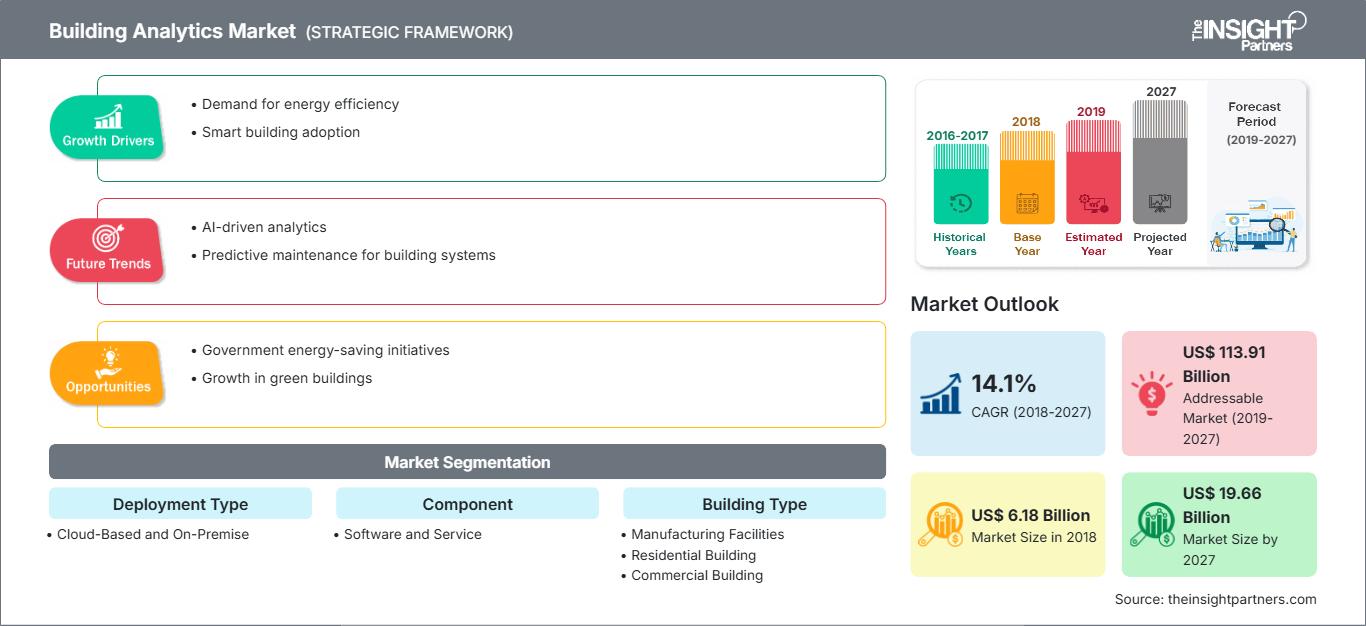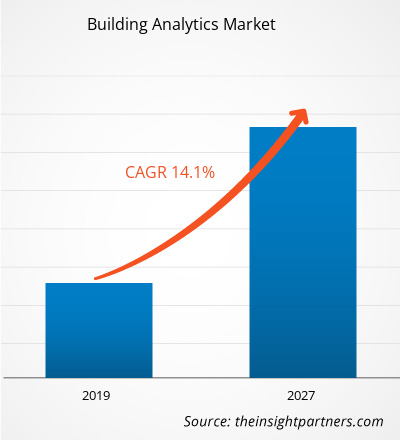Der globale Markt für Gebäudeanalysen wurde 2018 auf 6.181,4 Millionen US-Dollar geschätzt und soll zwischen 2019 und 2027 mit einer durchschnittlichen jährlichen Wachstumsrate (CAGR) von 14,1 % wachsen.
Der Markt für Gebäudeanalysen wächst weltweit. Steigende Energiepreise, immer strengere Richtlinien für Gebäudeenergie und die Maximierung der Betriebseffizienz im Gebäude- und Facility Management werden in den kommenden Jahren voraussichtlich die wichtigsten treibenden Kräfte des Marktes sein.
Der Bericht konzentriert sich auf eine detaillierte Segmentierung des Marktes für Gebäudeanalysen nach Bereitstellungsart, Komponente, Gebäudetyp und Anwendung. Die geografische Segmentierung des Berichts umfasst fünf Hauptregionen: Nordamerika, Europa, Asien-Pazifik (APAC), Naher Osten und Afrika (MEA) sowie Südamerika (SA). Der regionale Markt wurde weiter nach Ländern segmentiert. Nach Anwendung hatte Energiemanagement 2018 den größten Anteil am Markt für Gebäudeanalysen.
Passen Sie diesen Bericht Ihren Anforderungen an
Sie erhalten kostenlos Anpassungen an jedem Bericht, einschließlich Teilen dieses Berichts oder einer Analyse auf Länderebene, eines Excel-Datenpakets sowie tolle Angebote und Rabatte für Start-ups und Universitäten.
Markt für Gebäudeanalysen: Strategische Einblicke

-
Holen Sie sich die wichtigsten Markttrends aus diesem Bericht.Dieses KOSTENLOSE Beispiel umfasst Datenanalysen, die von Markttrends bis hin zu Schätzungen und Prognosen reichen.
Der Bericht bietet einen Überblick über den globalen Markt für Gebäudeanalysen mit detaillierter Marktsegmentierung. Er analysiert die aktuelle Marktsituation und prognostiziert den Markt bis 2027. Er deckt die Marktdynamik ab, die den Markt für Gebäudeanalysen im Prognosezeitraum beeinflusst. Darüber hinaus analysiert er das Wettbewerbsumfeld, geografische Trends und Chancen im Markt für Gebäudeanalysen in allen geografischen Regionen. Er enthält detaillierte Unternehmensprofile der wichtigsten Akteure im Markt für Gebäudeanalysen sowie deren Marktstrategien. Der Bericht bietet außerdem eine PEST- und eine SWOT-Analyse für alle im Bericht vorgestellten Unternehmen.
Derzeit ist die Marktdurchdringung im Bereich Gebäudeanalysen in Europa höher als in allen anderen Märkten weltweit. Die 2012 eingeführte Energieeffizienzrichtlinie der Europäischen Union legte eine Reihe verbindlicher Maßnahmen fest, um die EU dabei zu unterstützen, ihr Energieeffizienzziel von 20 % bis 2020 zu erreichen. Die Richtlinie verpflichtet alle EU-Länder, Energie entlang der gesamten Energiekette, d. h. von der Produktion bis zum Endverbrauch, effizienter zu nutzen. 2016 wurde außerdem eine Aktualisierung der Energieeffizienzrichtlinie vorgeschlagen, die ein neues Energieeffizienzziel von 30 % bis 2030 sowie Maßnahmen zur Erreichung dieses Ziels beinhaltete. In der EU entfallen rund 40 % des gesamten Energieverbrauchs und 36 % der gesamten CO2-Emissionen auf Gebäude. Rund 35 % der Gebäude in der EU sind älter als 50 Jahre, und fast 75 % des Gebäudebestands sind energieineffizient, obwohl jährlich nur 0,4–1,2 % des Gebäudebestands saniert werden. Daher birgt eine verstärkte Sanierung bestehender Gebäude das Potenzial, erhebliche Energieeinsparungen zu erzielen. Diese Tatsachen bieten dem Markt für Gebäudeanalytik hervorragende Wachstumschancen.
Gebäudeanalytik
Regionale Einblicke in den Markt für GebäudeanalysenDie Analysten von The Insight Partners haben die regionalen Trends und Faktoren, die den Markt für Gebäudeanalysen im Prognosezeitraum beeinflussen, ausführlich erläutert. In diesem Abschnitt werden auch die Marktsegmente und die geografische Lage in Nordamerika, Europa, dem asiatisch-pazifischen Raum, dem Nahen Osten und Afrika sowie Süd- und Mittelamerika erörtert.
Umfang des Marktberichts zur Gebäudeanalyse
| Berichtsattribut | Einzelheiten |
|---|---|
| Marktgröße in 2018 | US$ 6.18 Billion |
| Marktgröße nach 2027 | US$ 19.66 Billion |
| Globale CAGR (2018 - 2027) | 14.1% |
| Historische Daten | 2016-2017 |
| Prognosezeitraum | 2019-2027 |
| Abgedeckte Segmente |
By Bereitstellungstyp
|
| Abgedeckte Regionen und Länder |
Nordamerika
|
| Marktführer und wichtige Unternehmensprofile |
|
Dichte der Marktteilnehmer im Bereich Gebäudeanalyse: Verständnis ihrer Auswirkungen auf die Geschäftsdynamik
Der Markt für Gebäudeanalytik wächst rasant. Die steigende Nachfrage der Endnutzer ist auf Faktoren wie veränderte Verbraucherpräferenzen, technologische Fortschritte und ein stärkeres Bewusstsein für die Produktvorteile zurückzuführen. Mit der steigenden Nachfrage erweitern Unternehmen ihr Angebot, entwickeln Innovationen, um den Bedürfnissen der Verbraucher gerecht zu werden, und nutzen neue Trends, was das Marktwachstum weiter ankurbelt.

- Holen Sie sich die Markt für Gebäudeanalysen Übersicht der wichtigsten Akteure
Einige der führenden Akteure auf diesem Markt sind (in alphabetischer Reihenfolge): Acorn Engineering Group Limited, Arup Group, AT Kearney, Buildingiq, Buildinglogix, Buildpulse, Coppertree Analytics, Crestron Electronics, Delta Electronics, Ecovox, Energy Advantage, Enernoc, Engie Insight, Environmental Systems Inc., General Electric, Gooee, Gridpoint, Honeywell, IBM Corporation, Iconics, Schneider Electric, Senseware, Siemens, SkyFoundry, Waibel Energy Systems, Xchanging PLC (CSC Computer Sciences International Operations Limited) und andere.
- Historische Analyse (2 Jahre), Basisjahr, Prognose (7 Jahre) mit CAGR
- PEST- und SWOT-Analyse
- Marktgröße Wert/Volumen – Global, Regional, Land
- Branchen- und Wettbewerbslandschaft
- Excel-Datensatz
Aktuelle Berichte
Erfahrungsberichte
Grund zum Kauf
- Fundierte Entscheidungsfindung
- Marktdynamik verstehen
- Wettbewerbsanalyse
- Kundeneinblicke
- Marktprognosen
- Risikominimierung
- Strategische Planung
- Investitionsbegründung
- Identifizierung neuer Märkte
- Verbesserung von Marketingstrategien
- Steigerung der Betriebseffizienz
- Anpassung an regulatorische Trends






















 Kostenlose Probe anfordern für - Markt für Gebäudeanalysen
Kostenlose Probe anfordern für - Markt für Gebäudeanalysen